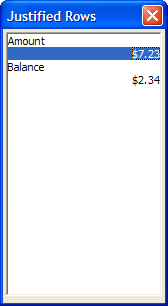List Box (Single Field Multi-Column) Control Syntax
Syntax
Arguments
- %C % ^#
Character. The leading [%C% and trailing ] and ^# characters are required.
- CW
Numeric. Column width in characters.
- ;H
Character. Enables horizontal scrolling.
- Width
Numeric. The width of the control.
- Height
Numeric. The height of the control.
- Variable_Name
Character. The name of a character variable to receive the user selection, or a numeric variable to receive the index value of the selected radio button. The index of the top-most button is 1.
- Choices
Character. See Choices Syntax. You must either use the use {DATA} command or the K Directive to preserve the formatting of selected items.
- Event
Character. Optional. See Event Syntax.
- Enabled
Logical. Optional. See Enabled Syntax.
Description
One or more Multi-Select List Box objects may appear inside the Format section of a UI_DLG_BOX() function. The selections are stored in the %mw% variable.
Example
For example, the following script allows you to select multiple cities:
cities = <<%dlg%
Atlanta
New York
Los Angeles
Boston
Johannesburg
Sydney
%dlg%
ui_dlg_box("Multi-Select List Box",<<%dlg%
{wrap=30}
%M%.30,5cities_chosen^#cities;
{line=1,0};
This variable shows what entries in the above list box are selected.;
%mw%.30,5cities_chosen;
%dlg%)This example changes the justification of alternate rows:
list = <<%txt%
Amount
{J=R}$7.23
Balance
{J=R}$2.34
%txt%
ui_dlg_box("test","%O={@@}%.30,20selected^#list")See Also

